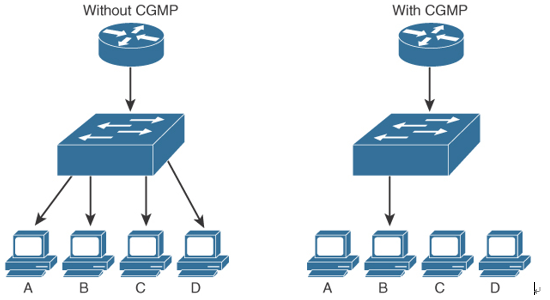CGMP – IP Multicast and Network Management
Cisco Group Management Protocol (CGMP) is a Cisco-proprietary protocol implemented to control multicast traffic at Layer 2 (see Figure 5-2). Because a Layer 2 switch is unaware of Layer 3 IGMP messages, it cannot keep multicast packets from being sent to all ports.

Figure 5-2 CGMP
When a router receives an IGMP report, it processes the report and then sends a CGMP message to the switch. The switch can then forward the multicast messages to the port with the host receiving multicast traffic. CGMP fast-leave processing allows the switch to detect IGMP version 2 leave messages sent by hosts on any of the switch ports. When a host sends an IGMPv2 leave message, the switch can then disable multicasting for the port.
CGMP is no longer used and is not covered on the ENSLD 300-420 exam. IGMP snooping is the standards-based method used in today’s networks.
IGMP Snooping
IGMP snooping is a standards-based method for switches to control multicast traffic at Layer 2. It has replaced CGMP. It listens to IGMP messages between the hosts and routers. If a router or an IGMP querier host sends an IGMP query message, the switch adds the host to the multicast group and permits that port to receive multicast traffic. The port is removed from multicast traffic if the host sends an IGMP leave message to the router. The disadvantage of IGMP snooping is that it has to process every IGMP control message, which can impact the CPU utilization of the switch.
Sparse Versus Dense Multicast
IP multicast traffic for a particular (source, destination group) multicast pair is transmitted from the source to the receivers using a spanning tree from the source that connects all the hosts in the group. Multicast destinations are represented in the following form:
- (*,G): This means any source is sending to group G.
- (S,G): This means source S is sending to group G.
Any multicast transmission has a Class D multicast group address, G. A multicast group can have more than one source, and each such source will also have a “regular” (Class A, B, or C or CIDR) Internet address, S.
Each destination host registers itself as a member of interesting multicast groups through the use of IGMP. Routers keep track of these groups dynamically and build distribution trees that chart paths from each sender to all receivers. IP multicast routing protocols follow two approaches.
The first approach assumes that the multicast group members are densely distributed throughout the network (with many of the subnets containing at least one group member), that all devices want to receive multicast traffic, and that bandwidth is plentiful. The approach with dense multicast routing protocols is to flood the traffic throughout the network and then, at the request of receiving routers, stop the flow of traffic on branches of the network that have no members of the multicast group. Multicast routing protocols that use this technique of flooding the network include DVMRP, Multicast Open Shortest Path First (MOSPF), and Protocol Independent Multicast–Dense Mode (PIM-DM).
The second approach to multicast routing assumes that multicast group members are sparsely distributed throughout the network, that not all devices want to receive multicast traffic, and that bandwidth is not necessarily widely available. Sparse mode does not imply that the group has few members—just that they are widely dispersed. The approach with sparse multicast routing protocols is not to send traffic until it is requested by the receiving routers or hosts. Multicast routing protocols of this type include Core-Based Trees (CBT) and Protocol Independent Multicast–Sparse Mode (PIM-SM). CBT is not widely deployed and is not discussed in this book.
